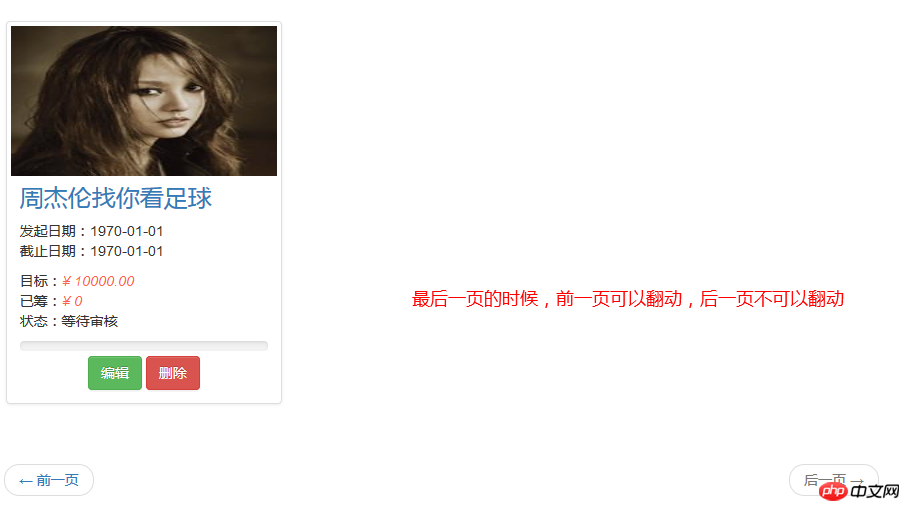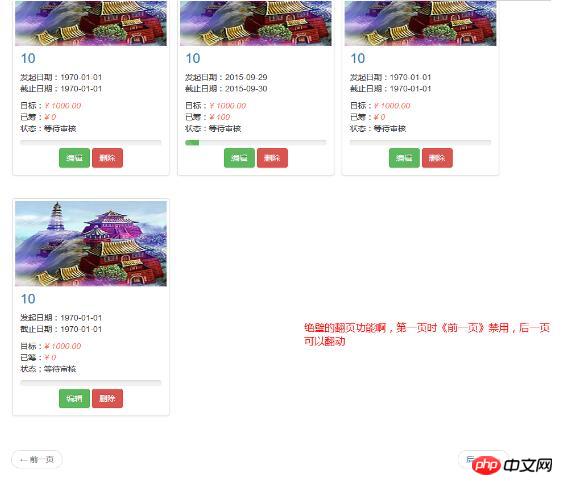Bootstrap implements page turning effect
Bootstrap, from Twitter, is a very popular front-end framework. Bootstrap is based on HTML, CSS, and JavaScript. It is simple and flexible, making web development faster. This article mainly introduces Bootstrap to achieve page turning effect in detail, which has certain reference value. Interested friends can refer to it.
Advantages:
Supports partial refresh;
As long as it is a list, the component can be loaded;
Supports dynamic data binding;
Of course And absolutely simple and practical.
Rendering
At the last page:

At the first page:

Implementation
①、Layout of page turning component
<%@ page language="java" contentType="text/html; charset=utf-8" pageEncoding="utf-8"%>
<%@ include file="/components/common/taglib.jsp"%>
<c:if test="${urlParas == null}">
<c:set var="urlParas" value="" />
</c:if>
<c:if test="${(totalPage > 0) && (currentPage <= totalPage)}">
<c:set var="startPage" value="${currentPage - 4}" />
<c:if test="${startPage < 1}">
<c:set var="startPage" value="1" />
</c:if>
<c:set var="endPage" value="${currentPage + 4}" />
<c:if test="${endPage > totalPage}">
<c:set var="endPage" value="totalPage" />
</c:if>
<nav>
<ul class="pager">
<c:if test="${currentPage <= 8}">
<c:set var="startPage" value="1" />
</c:if>
<c:if test="${(totalPage - currentPage) < 8}">
<c:set var="endPage" value="${totalPage}" />
</c:if>
<c:choose>
<c:when test="${currentPage == 1}">
<li class="previous disabled"><a>
<span aria-hidden="true">←</span>
前一页
</a></li>
</c:when>
<c:otherwise>
<li class="previous"><a href="javascript:;" pageNum="${currentPage - 1}" rel="${rel}" urlParas="${urlParas}">
<span aria-hidden="true">←</span>
前一页
</a></li>
</c:otherwise>
</c:choose>
<c:choose>
<c:when test="${currentPage == totalPage}">
<li class="next disabled"><a>
后一页
<span aria-hidden="true">→</span>
</a></li>
</c:when>
<c:otherwise>
<li class="next"><a href="javascript:;" pageNum="${currentPage + 1}" rel="${rel}" urlParas="${urlParas}">
后一页
<span aria-hidden="true">→</span>
</a></li>
</c:otherwise>
</c:choose>
</ul>
</nav>
</c:if>
pageNum: which page
rel: which p’s id to refresh
-
urlParas: Other parameters
<!DOCTYPE html PUBLIC "-//W3C//DTD XHTML 1.0 Transitional//EN" "http://www.w3.org/TR/xhtml1/DTD/xhtml1-transitional.dtd">
<%@ page language="java" contentType="text/html; charset=utf-8" pageEncoding="utf-8"%>
<%@ include file="/components/common/taglib.jsp"%>
<c:set var="currentPage" value="${dealPage.pageNumber}" />
<c:set var="totalPage" value="${dealPage.totalPage}" />
<c:set var="rel" value="deal_items" />
<c:set var="urlParas" value="" />
<%@ include file="/components/common/paginate.jsp"%>
- currentPage: page number
- totalPage: total page number
- rel: id of partial refresh p
- urlParas: Other parameters, none
$(function() {
// 翻页组件
$("ul[class=pager] li:not(.disabled) > a", $p).each(function() {
$(this).click(function(event) {
var $this = $(this);
YUNM.debug($this.attr("pageNum") + "、" + $this.attr("rel") + "、" + $this.attr("urlParas"));
var pageNum = $this.attr("pageNum");
// 准备翻页事件
if (pageNum && pageNum.isPositiveInteger()) {
yunmPageBreak({
rel : $this.attr("rel"),
data : {
pageNum : pageNum,
urlParas : $this.attr("urlParas")
}
});
}
event.preventDefault();
return false;
});
});
});- After the page is loaded, obtain the page-turning a tag and load the page-turning function for it.
- Set pageNum, this must be passed
- to get the partial refresh p. This place needs to be improved in the future. It seems not good to get it through id.
- Pass extra parameters urlParas
- Finally prevent existing events of a tag.
/**
* 翻页
*
* @param options
*/
function yunmPageBreak(options) {
var op = $.extend({
rel : "",
data : {
pageNum : "",
numPerPage : "",
orderField : "",
orderDirection : "",
urlParas : ""
},
callback : null
}, options);
var $panel = $("#" + op.rel);
if (op.rel) {
var dataId = $panel.attr("data");
var url = $panel.attr("url");
// 设置p上的其他参数
if (dataId) {
if (dataId.indexOf(",") != -1) {
$.each(dataId.split(","), function(index, id) {
if ($("#" + id) && $("#" + id).val()) {
url = addMoreParamForUrl(url, id, $("#" + id).val());
}
});
} else {
if ($("#" + dataId) && $("#" + dataId).val()) {
url = addMoreParamForUrl(url, dataId, $("#" + dataId).val());
}
}
}
// 局部刷新
$panel.ajaxUrl({
type : "POST",
url : url,
data : op.data,
callback : function(response) {
if ($.isFunction(op.callback))
op.callback(response);
}
});
}
}- ##This string of code is also easy to understand, get ajax Requested url
- Get the parameter data of ajax request
- As for the ajaxUrl method, please refer to my talk about ajax partial refresh, I think this is Partial refresh is still very practical.
④. Paging data acquisition
public Page<Deals> paginateCreateDealsByUid(int pageNumber, int pageSize, Long uid) {
Page<Deals> deals = paginate(pageNumber, pageSize, "select y.*",
"from ym_dels y where y.uid = ? order by y.opertime desc", uid);
return deals;
}- jfinal has naturally provided a very good Page turning function paginate method.
- Just need to return the corresponding data.
- Related recommendations:
The above is the detailed content of Bootstrap implements page turning effect. For more information, please follow other related articles on the PHP Chinese website!

Hot AI Tools

Undresser.AI Undress
AI-powered app for creating realistic nude photos

AI Clothes Remover
Online AI tool for removing clothes from photos.

Undress AI Tool
Undress images for free

Clothoff.io
AI clothes remover

AI Hentai Generator
Generate AI Hentai for free.

Hot Article

Hot Tools

Notepad++7.3.1
Easy-to-use and free code editor

SublimeText3 Chinese version
Chinese version, very easy to use

Zend Studio 13.0.1
Powerful PHP integrated development environment

Dreamweaver CS6
Visual web development tools

SublimeText3 Mac version
God-level code editing software (SublimeText3)

Hot Topics
 1384
1384
 52
52
 How to get the bootstrap search bar
Apr 07, 2025 pm 03:33 PM
How to get the bootstrap search bar
Apr 07, 2025 pm 03:33 PM
How to use Bootstrap to get the value of the search bar: Determines the ID or name of the search bar. Use JavaScript to get DOM elements. Gets the value of the element. Perform the required actions.
 How to use bootstrap in vue
Apr 07, 2025 pm 11:33 PM
How to use bootstrap in vue
Apr 07, 2025 pm 11:33 PM
Using Bootstrap in Vue.js is divided into five steps: Install Bootstrap. Import Bootstrap in main.js. Use the Bootstrap component directly in the template. Optional: Custom style. Optional: Use plug-ins.
 How to do vertical centering of bootstrap
Apr 07, 2025 pm 03:21 PM
How to do vertical centering of bootstrap
Apr 07, 2025 pm 03:21 PM
Use Bootstrap to implement vertical centering: flexbox method: Use the d-flex, justify-content-center, and align-items-center classes to place elements in the flexbox container. align-items-center class method: For browsers that do not support flexbox, use the align-items-center class, provided that the parent element has a defined height.
 How to write split lines on bootstrap
Apr 07, 2025 pm 03:12 PM
How to write split lines on bootstrap
Apr 07, 2025 pm 03:12 PM
There are two ways to create a Bootstrap split line: using the tag, which creates a horizontal split line. Use the CSS border property to create custom style split lines.
 How to resize bootstrap
Apr 07, 2025 pm 03:18 PM
How to resize bootstrap
Apr 07, 2025 pm 03:18 PM
To adjust the size of elements in Bootstrap, you can use the dimension class, which includes: adjusting width: .col-, .w-, .mw-adjust height: .h-, .min-h-, .max-h-
 How to set up the framework for bootstrap
Apr 07, 2025 pm 03:27 PM
How to set up the framework for bootstrap
Apr 07, 2025 pm 03:27 PM
To set up the Bootstrap framework, you need to follow these steps: 1. Reference the Bootstrap file via CDN; 2. Download and host the file on your own server; 3. Include the Bootstrap file in HTML; 4. Compile Sass/Less as needed; 5. Import a custom file (optional). Once setup is complete, you can use Bootstrap's grid systems, components, and styles to create responsive websites and applications.
 How to insert pictures on bootstrap
Apr 07, 2025 pm 03:30 PM
How to insert pictures on bootstrap
Apr 07, 2025 pm 03:30 PM
There are several ways to insert images in Bootstrap: insert images directly, using the HTML img tag. With the Bootstrap image component, you can provide responsive images and more styles. Set the image size, use the img-fluid class to make the image adaptable. Set the border, using the img-bordered class. Set the rounded corners and use the img-rounded class. Set the shadow, use the shadow class. Resize and position the image, using CSS style. Using the background image, use the background-image CSS property.
 What to do if the Bootstrap Table uses AJAX to get data garbled
Apr 07, 2025 am 11:54 AM
What to do if the Bootstrap Table uses AJAX to get data garbled
Apr 07, 2025 am 11:54 AM
Solutions to the garbled code of Bootstrap Table when using AJAX to obtain data from the server: 1. Set the correct character encoding of the server-side code (such as UTF-8). 2. Set the request header in the AJAX request and specify the accepted character encoding (Accept-Charset). 3. Use the "unescape" converter of the Bootstrap Table to decode the escaped HTML entity into original characters.





